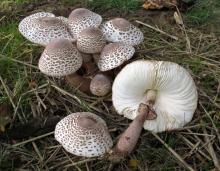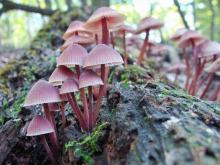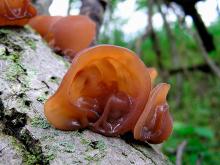Mushrooms
Media

Species Types
Scientific Name
Tylopilus felleus
Description
The bitter bolete has a large, tannish brown cap with pinkish white pores and a webbed, tannish brown stalk. It grows singly or scattered on the ground in mixed woods.
Media

Species Types
Scientific Name
Leucoagaricus americanus (Lepiota americana)
Description
The reddening lepiota is a large, reddish brown mushroom with a scaly cap and a ring on the stalk; it bruises dark red. It grows singly or in clusters in mulch piles, waste areas, and around stumps.
Media

Species Types
Scientific Name
Amanita spp. (about 600 species, worldwide)
Description
This large group of mushrooms accounts for 90 percent of mushroom-related deaths, so every mushroom hunter should be familiar with amanitas. They contain one of the deadliest poisons found in nature!
Media

Species Types
Scientific Name
Mycena haematopus
Description
The bleeding mycena is a small mushroom with a bell-shaped, reddish brown cap that bleeds dark red when cut. It usually grows in clusters on decaying wood.
Media

Species Types
Scientific Name
Amanita rubescens
Description
The blusher has a tan to reddish brown cap with pinkish brown patches and a ring on the stalk; the entire mushroom bruises reddish. It grows on the ground in oak woods and under white pines.
Media

Species Types
Scientific Name
Laccaria laccata
Description
The common laccaria has a small, brownish pink cap with a central depression; the gills and stalk are a pale pinkish brown. Grows scattered or in groups in poor or sandy soil in mixed woods.
Media

Species Types
Scientific Name
Russula emetica
Description
The emetic russula has a uniformly red cap with off-white gills and stalk; its flesh and stalk are brittle. It grows singly or in groups, on moss and in mixed woods.
Media

Species Types
Scientific Name
Pluteus atricapillus (formerly P. cervinus)
Description
The fawn mushroom has a brownish gray cap with whitish to pinkish gills and a whitish stalk. It grows singly or scattered, on dead wood or on the ground over buried wood.
Media

Species Types
Scientific Name
Auricularia auricula (formerly A. auricula-judae)
Description
The wood ear is a reddish brown to grayish black, rubbery, earlike or cup-shaped mushroom. It usually grows in groups on rotting wood.
Media

Species Types
Scientific Name
Lycogala epidendrum
Description
Wolf's-milk slime looks like little, round, reddish pink balls that exude a pinkish-gray paste when popped. It grows in groups on dead wood, especially large logs. It's not really a mushroom!
See Also



Media

Species Types
Scientific Name
Monotropa hypopitys
Description
Pinesap is a plant that puts the "wild" in wildflower! It lacks chlorophyll, so its roots connect to fungi underground and absorb nutrients from the fungi.
Media

Species Types
Scientific Name
Cladophora, Pithophora, and Spirogyra spp., and others
Description
Filamentous green algae forms green, cottony masses that are free-floating or attached to rocks, debris, or other plants.
Media

Species Types
Scientific Name
Monotropa uniflora
Description
Indian pipe lacks chlorophyll, so it is white, not green. Below ground, its roots join with fungi that connect to tree roots. This plant, then, takes nourishment indirectly from the trees.
About Mushrooms in Missouri
Mushrooms are a lot like plants, but they lack chlorophyll and have to take nutrients from other materials. Mushrooms are neither plants nor animals. They are in a different kingdom — the fungi. Fungi include the familiar mushroom-forming species, plus the yeasts, molds, smuts, and rusts.
Always be cautious when eating edible mushrooms. Be absolutely sure of the ID, and only eat a small amount the first time you try it to avoid a reaction..





















